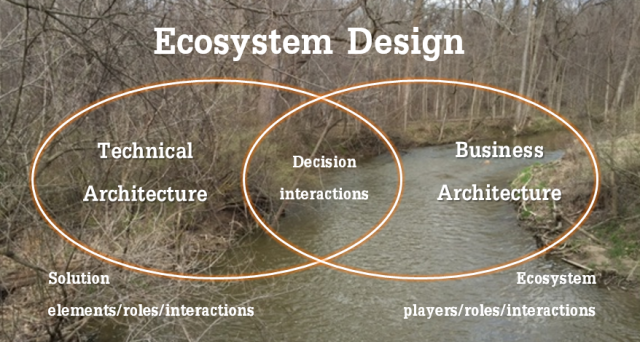This week I’ve had ecosystems on the brain. It started with an excellent discussion with a customer who is eagerly waiting for the release of our N-Squared tool so that he can model, better understand and communicate the business architecture of an industry that he is targeting.
It continued when I read Mani Vadari’s excellent summary of the disruptions that Distributed Energy Resources (DERs) are causing within the electric utility ecosystem.
The third strike was the walk I just finished down Fitch road, across Little Cedar Creek (picture background) on this blustery April day. I draw inspiration from the natural ecosystem that surrounds me; enjoying the emerging green in the forest despite yesterday’s brief snow gale.

While my influence on the natural ecosystem is fairly limited, I am compelled to analyze and innovate almost daily in the technical and business ecosystems in which I participate. My tool for doing so is to build mental models of the technical/solution architecture(s) within any domain and also the business architecture(s) that enable, deliver and sustain these solutions. But a mental model stored in my head only creates personal value; making it visible and explicit within an Architecture and Interaction Management (N-Squared) software tool invites others to critique, add value and leverage these models for their own purposes.
I think of a Technical Architecture as a multi-layered model of a broad problem space, that includes:
- Hierarchical decomposition of roles/functions/jobs-to-be-done, plus their interactions.
- Solution elements, i.e. hierarchy of systems, subsystems and components that deliver these roles/functions/jobs, plus their real-world interactions/interfaces.
A Business Architecture follows a similar construct and represents the ecosystem players, their roles (e.g. Technology Developer, Solutions Integrator, Operator/End User) and interactions, i.e. the entire value chain for the problem domain.
A complete ecosystem model should capture both the Technical and Business Architectures. Innovation can occur on either side of this model and trigger a disruption to the other side (see Mani’s discussion of how distributed energy technologies such as solar, wind and storage disrupt regulated electric utilities). This puts a premium on explicitly understanding the interactions between the design decisions on either side of the model.
I think the ability to proactively manage decision interactions (before you pull the trigger on a new technical or business model innovation) is a critical new skill that will help companies survive and thrive in the face of rapid change. This skill is easier caught than taught, so I’m happy to help you create your first complete ecosystem model and understand the ripple effects of your latest innovation.
